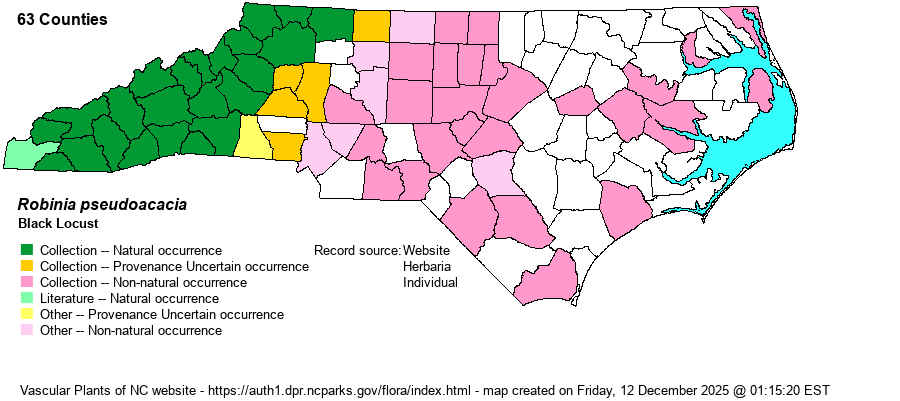| Author | L. | |
| Distribution | Throughout the Mountains and foothills, its primary natural range. Now occurs over most of the Piedmont, and scattered in the Coastal Plain. Occurrences from the central Piedmont eastward are certainly not native; those from the western Piedmont but not in the foothills are of uncertain provenance. Weakley's (2018) range map shows it as native in the Mountains but as non-native in the Piedmont and Coastal Plain.
Originally, this was a central and southern Appalachian endemic, native north to PA; but it has been planted so much, and escaped, that it is now present over most of the country and into eastern Canada.
| |
| Abundance | Common and widespread in the Mountains and foothills. Infrequent to fairly common in the central Piedmont, but uncommon to rare in the eastern Piedmont and Coastal Plain. | |
| Habitat | Originally it was/is a species of mesic to rich hardwood forests, mostly on slopes, at middle and lower elevations in the mountains and foothills, including cove forests. Farther eastward it is more often found on rich soils of hardwood slopes or riverbanks, but it can be seen in a variety of thickets and roadsides. It is not normally found in sandy or overly dry sites. |
| Phenology | Blooms from April into June, and fruits from July to November. | |
| Identification | This is a medium to occasionally large tree, often reaching 60-70 feet tall. It normally does not quite reach the canopy of most forests, but it certainly is a frequent member of the understory of many mesic to rich montane and foothill hardwood forests. It has deciduous leaves, with 7-19 leaflets; the drooping racemes of white flowers that are 4-8 inches long often festoon the trees in mid-to late spring and are easily noted from a distance. It can be confused as a tree mainly with Honey Locust (Gleditsia triacanthos), but that tree has narrow leaflets, very long thorns (as opposed to triple thorns that are less than 1-inch long), and a much longer pod (legume). | |
| Taxonomic Comments | Most older references used a hyphen in the name – i.e., R. pseudo-acacia.
| |
| Other Common Name(s) | None | |
| State Rank | S5 | |
| Global Rank | G5 | |
| State Status | | |
| US Status | | |
| USACE-agcp | UPL link |
| USACE-emp | FACU link |

